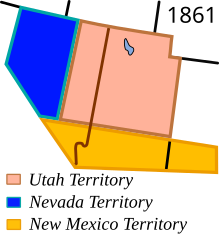Nevada
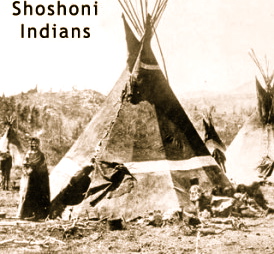
Shoshone Paiute History
This is the first of three videos showing a short version of Shoshone Paiute History. Please watch all three to get the full effect of how these Indian Tribes were treated by the White Men in the late 1800’s. It will make you think a bit!! Go to our website at http://www.shopaitribes.org.
 Timeline of Nevda: 1200’s – 1700’s
Timeline of Nevda: 1200’s – 1700’s
- (1200’s) Mojave Indians inhabited the land, planted crops along river banks
- (1519) Area claimed by Spain
- (1609) Town of Santa Fe established as Spanish-Indian trade center
- (1776) Spanish missionaries arrived in southern Nevada
1800’s
- (1821) Mexico took control of the Nevada area
- (1826) Peter Skene Ogden explored the Snake River; Jedediah Smith led expedition to Muddy River
- (1828) Ogden discovered Humboldt River
- (1830) Santa Fe merchant, Antonio Armijo, led first pack train from Santa Fe to Los Angeles
- (1833) Joseph Walker led expedition along Humboldt River
- (1841) Earliest immigrants, the Bartleson-Bidwell party, passed through Nevada
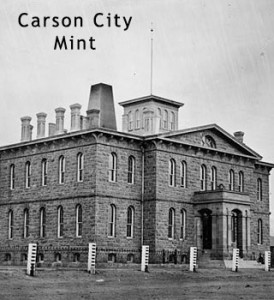 (1842) Capt. John Fremont and party were first white men to view Lake Tahoe
(1842) Capt. John Fremont and party were first white men to view Lake Tahoe- (1843) Joseph Walker led first group of wagons across the Sierra
- (1846) Donner party became trapped in the Sierras. 47 out of 87 perished.
- (1848) The United States gained control of Nevada after the Mexican-American War ended
- (1849) Over 60,000 settlers in covered wagons (49ers) passed through Nevada on their way west
- (1851) Gold was discovered near Dalton
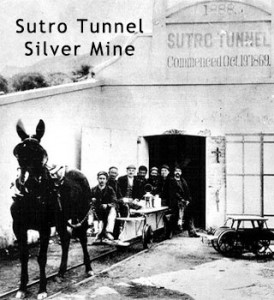 (1859) Silver discovery brought thousands into the state; Virginia City developed almost overnight
(1859) Silver discovery brought thousands into the state; Virginia City developed almost overnight- (1860) The Nevada Territory was created
- (1864) Nevada became 36th state
- (1869) Gambling was legalized; an earthquake shook Reno; transcontinental railroad crossed Nevada for the first time
- (1870) U S Mint established in Carson City; first train robbery in the Western U S occurred
- (1875) Virginia City was consumed by the great fire
- (1888-90) Nearly 100 inches of snow fell in northern Nevada – the “White Winter”
- (1890) Elizabeth Potts first woman to be executed in Nevada
- (1894) The Great Meteor fell
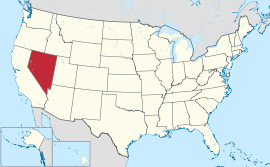 Nevada (
Nevada (![]() i/nəˈvædə/ or /nəˈvɒdə/) is a state in the western, mountain west, and southwestern regions of the United States. Nevada is the 7th most extensive, the35th most populous, and the 9th least densely populated of the 50 United States. Over two-thirds of Nevada’s people live in one single county, Clark County, which contains the Las Vegas–Paradise metropolitan area, where the state’s three largest incorporated cities are located. Nevada’s capital is Carson City.
i/nəˈvædə/ or /nəˈvɒdə/) is a state in the western, mountain west, and southwestern regions of the United States. Nevada is the 7th most extensive, the35th most populous, and the 9th least densely populated of the 50 United States. Over two-thirds of Nevada’s people live in one single county, Clark County, which contains the Las Vegas–Paradise metropolitan area, where the state’s three largest incorporated cities are located. Nevada’s capital is Carson City.
Nevada is largely desert and semiarid, with much of it located within the Great Basin. Areas south of the Great Basin are located within the Mojave Desert, while Lake Tahoe and the Sierra Nevada mountains lie on the western edge. Approximately 86% of the state’s land is owned by the US government under various jurisdictions, both civilian and military.
The name Nevada is derived from the nearby Sierra Nevada mountains, which means “snow-capped mountain range” in Spanish. The land comprising the modern state was inhabited by Native Americans of the Paiute, Shoshone, and Washoe tribes prior to European contact. It was subsequently claimed by Spain as a part of Alta California until the Mexican War of Independence brought it under Mexican control. The United States gained the territory in 1848 following its victory in the Mexican-American War and the area was eventually incorporated as part of Utah Territory in 1850. The discovery of silver at the Comstock Lode in 1859 led to a population boom that was an impetus to the creation of Nevada Territory out of western Utah Territory in 1861. Nevada became the 36th state on October 31, 1864.
The establishment of legalized gambling and lenient marriage and divorceproceedings in the 20th century transformed Nevada into a major tourist destination. The tourism industry remains Nevada’s largest employer, with mining continuing to be a substantial sector of the economy as Nevada is the fourth largest producer of gold in the world.
Nevada is officially known as the “Silver State” due to the importance of silver to its history and economy. It is also known as the “Battle Born State” because it achieved statehood during the Civil War and the “Sagebrush State” for the native eponymous plant.
Before 1861
See History of Utah, History of Las Vegas, and the discovery of the first major U.S. deposit of silver ore in Comstock Lode under Virginia City, Nevada in 1859.
Separation from Utah Territory
Nevada in the American Civil War
On March 2, 1861, the Nevada Territory separated from the Utah Territory and adopted its current name, shortened from Sierra Nevada (Spanish for “snowy range”).
The 1861 southern boundary is commemorated by Nevada Historical Markers 57 and 58 in Lincoln and Nye counties.
Statehood – Nevada in the American Civil War
Eight days prior to the presidential election of 1864, Nevada became the 36th state in the union. Statehood was rushed to the date of October 31 to help ensure Abraham Lincoln‘s reelection on November 8 and post-Civil War Republican dominance in Congress, as Nevada’s mining-based economy tied it to the more industrialized Union.
Nevada is notable for being one of only two states to significantly expand its borders after admission to the Union. – Nevada achieved its current southern boundaries on May 5, 1866, when it absorbed the portion of Pah-Ute County in the Arizona Territorywest of the Colorado River, essentially all of present day Nevada south of the 37th parallel. The transfer was prompted by the discovery of gold in the area, and it was thought by officials that Nevada would be better able to oversee the expected population boom. This area includes most of what is now Clark County. In 1868 another part of the western Utah Territory, whose population was seeking to avoid Mormon dominance, was added to Nevada in the eastern part of the state, setting the current eastern boundary.
Mining shaped Nevada’s economy for many years (see Silver mining in Nevada). When Mark Twain lived in Nevada during the period described in Roughing It, mining had led to an industry of speculation and immense wealth. However, both mining and population declined in the late 19th century. However, the rich silver strike at Tonopah in 1900, followed by strikes in Goldfield and Rhyolite, again put Nevada’s population on an upward trend.


